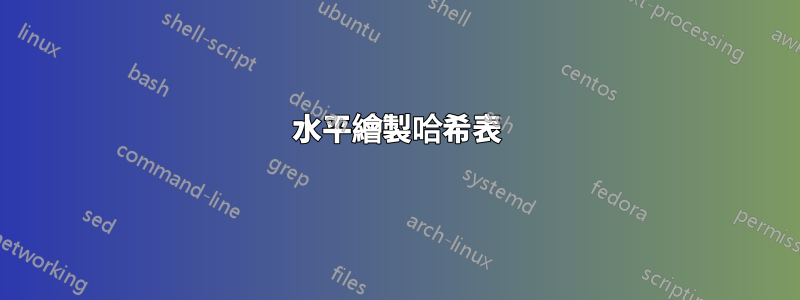
答案1
解決方案tikz:
\documentclass{article}
\usepackage{tikz}
\usepackage{expl3}
\usepackage{xparse}
\begin{document}
\newlength{\cellsize}
\setlength{\cellsize}{6mm}
\tikzset{
cell/.style = {
draw,
anchor=west,
minimum width=\cellsize,
minimum height=\cellsize,
text width=\cellsize,
inner sep=0pt,
outer sep=0pt,
line width=1pt,
execute at begin node = {\small\centering}
}
}
% current x coord
\newlength{\xcoord}
% current y coord
\newlength{\ycoord}
\ExplSyntaxOn
\tl_new:N \l_template_tl
\tl_set:Nn \l_template_tl {
\node[cell,*1] at (*2) {*3};
}
\DeclareDocumentCommand{\drawnode}{O{}m}{
% load template
\tl_set_eq:NN \l_tmpb_tl \l_template_tl
% fill node parameters
\tl_set:Nn \l_tmpa_tl {#1}
\regex_replace_once:nnN {*1} {\u{l_tmpa_tl}} \l_tmpb_tl
% increment x coord
\dim_add:Nn \xcoord {\cellsize}
% fill node location
\tl_set:Nx \l_tmpa_tl {\dim_use:N \xcoord, \dim_use:N \ycoord}
\regex_replace_once:nnN {*2} {\u{l_tmpa_tl}} \l_tmpb_tl
% fill node text
\tl_set:Nn \l_tmpa_tl {#2}
\regex_replace_once:nnN {*3} {\u{l_tmpa_tl}} \l_tmpb_tl
% use node
\tl_use:N \l_tmpb_tl
}
\ExplSyntaxOff
\begin{tikzpicture}
% initialize x, y coords before drawing
\setlength{\xcoord}{0mm}
\setlength{\ycoord}{0mm}
\drawnode[fill]{}
\drawnode{1}
\drawnode{2}
\drawnode{3}
\drawnode[draw=green]{4}
\drawnode[draw=green]{5}
\drawnode[draw=green]{6}
% draw another table
% initialize x, y coords before drawing
\setlength{\xcoord}{0mm}
\setlength{\ycoord}{-2cm}
\drawnode[draw=orange,fill=orange]{}
\drawnode{1}
\drawnode{2}
\drawnode{3}
\drawnode[draw=red]{4}
\drawnode[draw=blue]{5}
\drawnode[draw=green]{6}
\drawnode{7}
\end{tikzpicture}
\end{document}
添加額外信息
使用有星號的版本\drawnode
\documentclass{article}
\usepackage{tikz}
\usepackage{expl3}
\usepackage{xparse}
\begin{document}
\newlength{\cellsize}
\setlength{\cellsize}{6mm}
\tikzset{
cell/.style = {
draw,
anchor=west,
minimum width=\cellsize,
minimum height=\cellsize,
text width=\cellsize,
inner sep=0pt,
outer sep=0pt,
line width=1pt,
execute at begin node = {\small\centering}
}
}
% current x coord
\newlength{\xcoord}
% current y coord
\newlength{\ycoord}
\ExplSyntaxOn
\tl_new:N \l_template_tl
\tl_set:Nn \l_template_tl {
\node[cell,*1] at (*2) {*3};
}
\DeclareDocumentCommand{\drawnode}{sO{}m}{
% load template
\tl_set_eq:NN \l_tmpb_tl \l_template_tl
% fill node parameters
\tl_set:Nn \l_tmpa_tl {#2}
\regex_replace_once:nnN {*1} {\u{l_tmpa_tl}} \l_tmpb_tl
% increment x coord if it is not starred
\IfBooleanF{#1}{\dim_add:Nn \xcoord {\cellsize}}
% fill node location
\tl_set:Nx \l_tmpa_tl {\dim_use:N \xcoord, \dim_use:N \ycoord}
\regex_replace_once:nnN {*2} {\u{l_tmpa_tl}} \l_tmpb_tl
% fill node text
\tl_set:Nn \l_tmpa_tl {#3}
\regex_replace_once:nnN {*3} {\u{l_tmpa_tl}} \l_tmpb_tl
% use node
\tl_use:N \l_tmpb_tl
}
\ExplSyntaxOff
\begin{tikzpicture}
% initialize x, y coords before drawing
\setlength{\xcoord}{0mm}
\setlength{\ycoord}{0mm}
\drawnode[fill]{}
\drawnode{1}
% starred command will not increment x coord
\drawnode*[draw=none,yshift=5mm]{\tiny id1}
\drawnode*[draw=none,yshift=8mm]{\tiny id2}
\drawnode{2}
\drawnode{3}
\drawnode[draw=green]{4}
\drawnode[draw=green]{5}
\drawnode[draw=green]{6}
\end{tikzpicture}
\end{document}
答案2
正如我在評論中提到的,它可以透過簡單的表格、xcolor 和 hhline 來完成:
\documentclass{article}
\usepackage{hhline, array}
\usepackage[table, svgnames]{xcolor}
\usepackage{bigstrut}
\begin{document}
\sffamily\setlength{\bigstrutjot}{1ex}\setlength{\arrayrulewidth}{1pt}
\begin{tabular}{*{4}{!{\color{black}\vrule width 1pt}wc{3.2mm}}*{3}{|wc{3.2mm}}|}
\hhline{>{\arrayrulecolor{black}}---->{\arrayrulecolor{SeaGreen!60}}|---|<{\arrayrulecolor{black}} }
\cellcolor{black}\bigstrut & 1 & 2 & 3 & 4 & 5 & 6 \\
\hhline{>{\arrayrulecolor{black}}---->{\arrayrulecolor{SeaGreen!60}}|---|}
\end{tabular}
\end{document}
答案3
為此使用森林也不是我的第一個想法,但由於OP特別要求森林...
我們使用幻影節點作為根;所有其他節點都是根的子節點。重疊邊框效果是透過設定 TikZ 選項來實現的outer xsep=0。 (並繪製節點thick。)
\documentclass{article}
\usepackage{forest}
\begin{document}
\begin{forest}
[,phantom,s sep=0,for descendants={draw,thick,outer xsep=0}
[\phantom{0},fill]
[1]
[2]
[3]
[4,for current and following siblings=green]
[5]
[6]
]
\end{forest}
\end{document}
可以使用 控制節點的 z 順序draw tree processing order。這是節點行走風格,告訴森林以什麼順序繪製節點,請參考手冊的第 3.4.3 節。
使用處理程序定義節點行走是最簡單的.nodewalk style,請參閱手冊的第 3.8.8 節。為了獲得瘋狂的外觀c1b7b4b5b6b2b3,請寫下要繪製節點的順序(1745623;每個數字表示「移動到第 N 個子節點」;在本範例中,節點被重新編號以匹配子節點數字),將數字分隔開b(向後移動(使用假步驟)),並在整個事物之前加上c(current; 由於根是一個幻像節點,這實際上什麼也不做,但它給了我們一個可以返回到的節點 by b)。在這種特殊情況下,每個back都向上移動到父級 ( u),1u7u4u5u6u2u3也同樣有效。
\documentclass{article}
\usepackage{forest}
\begin{document}
\begin{forest}
draw tree processing order/.nodewalk style=c1b7b4b5b6b2b3,
[,phantom,s sep=0,for descendants={draw,thick,outer xsep=0}
[1,fill,text=white]
[2,red]
[3,green]
[4,orange]
[5,blue]
[6,yellow]
[7,brown]
]
\end{forest}
\end{document}








